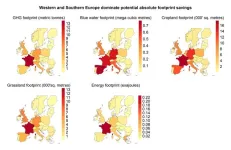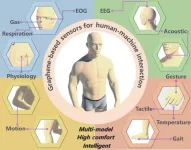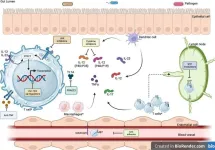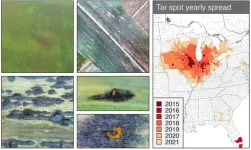(Press-News.org) Multiple sclerosis patients whose blood tests reveal elevated NfL, a biomarker of nerve damage, could see worsening disability one to two years later, according to a new study spearheaded by researchers at UC San Francisco.
The study is the first to quantify the timeframe preceding disability worsening in which injury to the central nervous system takes place, said co-first author Ahmed Abdelhak, MD, of the UCSF Department of Neurology and the Weill Institute for Neurosciences.
Almost 1 million Americans suffer from MS. In advanced cases, patients may have limited mobility and experience spasticity, weakness, poor coordination and incontinence. However, recent advances suggest that more severe symptoms can be substantially delayed or even averted.
“This rising of NfL up to two years before signs of disability worsening, represents the window when interventions may prevent worsening,” said Abdelhak.
In the study, publishing in JAMA Neurology on Nov. 6, 2023, and co-led by University Hospital and University of Basel, in Switzerland, the researchers looked at the incidence of disability worsening, defined as six months or more of increased impairment reflected in a higher score on the Expanded Disability Status Scale. They distinguished between disability worsening with relapse, which involves residual symptoms or the return of old ones following relapse, and gradual progression of symptoms without relapse.
91% at elevated risk of developing disability worsening
The researchers tracked data spanning a 10-year period from approximately 4,000 patient visits to UCSF, comprising the EPIC study, and from approximately 9,000 patient visits to multiple sites in Switzerland, comprising the SMSC study. Together, the two studies included almost 1,900 patients. Among those, 570 patients were identified with disability that continued to worsen, of which the majority were independent of relapses.
Elevated NfL levels were associated with up to a 91% higher risk of worsening disability with relapse approximately a year later, and up to a 49% higher risk of worsening disability without relapse nearly two years later, the researchers found.
“We think that NfL elevation occurs earlier in disability worsening without relapse,” said Abdelhak. This different pattern may indicate “a more prolonged process that decreases in intensity in advance of increased impairment,” said co-senior author Ari Green, MD, medical director of the UCSF Multiple Sclerosis and Neuroinflammation Center. “This aligns with recognition that death of nerve cells is a slow process that builds toward permanent disability and means that interventions to protect nerve cells might have time to also stop disability,” he said.
“In addition to the groundbreaking findings on the temporal relationship between NfL increases and gradual disease progression in MS, the study supports the important role of NfL as an early marker of nerve damage,” said co-senior author Jens Kuhle, MD, PhD, who led the Swiss cohort and is head of the Multiple Sclerosis Center at University Hospital and University of Basel, Switzerland. “Monitoring NfL levels might be able to detect disease activity with higher sensitivity than clinical exam or conventional imaging,” he said.
Future investigation will look into therapies that can stop progression during this period of elevated NfL.
Authors: Co-first author is Pascal Benkert, PhD, of University Hospital and University of Basel, Switzerland. Co-senior author is Jens Kuhle, MD, PhD, also of University Hospital and University of Basel, Switzerland. For other authors, please see the study.
Funding: Westridge Foundation Grants from F. Hoffmann-La Roche, Fishman Family, grant 320030-160221 from the Swiss National Research Foundation, grant R35NS111644 from the NIH/NINDS, the Valhalla Foundation. The UCSF MS biorepository is supported by grant Si-2001- 375 35701 from the National MS Society.
Disclosures: Please see the study.
About UCSF: The University of California, San Francisco (UCSF) is exclusively focused on the health sciences and is dedicated to promoting health worldwide through advanced biomedical research, graduate-level education in the life sciences and health professions, and excellence in patient care. UCSF Health, which serves as UCSF's primary academic medical center, includes top-ranked specialty hospitals and other clinical programs, and has affiliations throughout the Bay Area. UCSF School of Medicine also has a regional campus in Fresno. Learn more at https://ucsf.edu, or see our Fact Sheet.
###
Follow UCSF
ucsf.edu | Facebook.com/ucsf | YouTube.com/ucsf
END
A blood test shows MS worsening 1 to 2 years before it happens
2023-11-06
ELSE PRESS RELEASES FROM THIS DATE:
Major study validates Owkin’s best in class AI diagnostic for colorectal cancer biomarker aimed at optimizing patient access to immunotherapy
2023-11-06
Article in Nature Communications demonstrates that with 96% sensitivity, AI diagnostic MSIntuit™ CRC can rule out almost half of the MSS population of colorectal cancer patients unlikely to respond to checkpoint inhibitor therapy from additional screening.
Such AI-enabled solutions have the potential to improve lab efficiency, addressing global pathology shortages and reducing testing burden to match the right patients to the right therapies.
Paris and New York., 6 Nov 2023 – In a peer-reviewed study published today in Nature Communications, a team of scientists ...
Food waste prevention in Europe can generate major footprint savings
2023-11-06
New research shows that European food consumption draws unnecessarily excessively on global resources, which is why researchers are calling for political action. Many of the foods that are consumed in Europe are produced in countries outside Europe. Food loss – and waste later in the chain, (read more on waste terms below) – occurs along the food supply chain, from the primary agricultural sector in Europe or rest of the world, until it feeds mouths in Europe.
“Halving Europe’s food loss and waste, together with a redistribution of global food resources, could solve the challenges of food shortages in the ...
NIH grant expands UIC brain bank into citywide effort to study epilepsy, brain cancer
2023-11-06
A new virtual brain bank spanning five Chicago academic medical centers and led by University of Illinois Chicago will create a powerful new resource for clinical care and research on epilepsy, brain tumors and neurological disorders.
A $5 million grant from the National Institutes of Health will create a network of brain tissue research at UIC, Northwestern University, Lurie Children’s Hospital, Rush University and University of Chicago. The institutions will utilize a data platform developed at UIC called INTUITION that combines tissue data with clinical, functional, genetic and 3D imaging information to assist clinicians treating patients and help researchers better understand ...
Carbon-based sensors are poised to facilitate a seamless human-machine interface
2023-11-06
Interaction between machines and humans is paramount to the development of the new technologies of the metaverse, which are designed to augment the human experience through cloud computing and extended reality (XR). Graphene, a two-dimensional carbon material, has emerged as an ideal candidate for wearable sensor technology, paving the way for a new era of seamless human-machine interaction (HMI).
A team of material scientists led by Tian-Ling Ren from Tsinghua University in Beijing, China recently outlined the state of graphene-based HMI sensor technology ...
Chronic liver diseases: What new insights are there?
2023-11-06
Fatty liver diseases (FLD) have become a significant health concern worldwide, affecting millions. The two most common types of FLD are non-alcoholic fatty liver disease (NAFLD) and alcoholic-associated liver disease (ALD). NAFLD is associated with obesity, insulin resistance, and metabolic syndrome, while ALD is caused by excessive alcohol consumption. Both NAFLD and ALD can progress to liver fibrosis, cirrhosis, and, ultimately, hepatocellular carcinoma (HCC), a primary liver cancer with a poor prognosis.
Significant ...
Future therapies for managing inflammatory bowel disease
2023-11-06
Ulcerative colitis (UC) and Crohn's disease (CD) are chronic inflammatory bowel diseases (IBD) that affect the gastrointestinal tract. In recent decades, there have been significant advances in the understanding of IBD pathophysiology and the development of new treatments.
The International Organisation for the Study of Inflammatory Bowel Diseases (IOIBD) developed the Selecting Therapeutic Targets in Inflammatory Bowel Disease (STRIDE) programs, which recommend specific treatment goals for UC and CD in children ...
A joint research team from South Korea and the United States has identified a new gene classification system for gastric cancer
2023-11-06
- A multicenter study of the MD Anderson, Korea University, Yonsei University, and other institutions
- Establishing subtypes of gastric cancer classification to lay the foundation of personalized treatment
Professor Sang Cheul Oh of the Division of Oncology/Hematology, Department of Internal Medicine, Korea University College of Medicine, Professor Sang‑Hee Kang of the Department of Surgery, Korea University’s Guro Hospital, and Professor Sun Young Yim of the Division of Gastroenterology and Hepatology, Department of Internal Medicine, Korea University College of Medicine announced a new genetic classification system ...
MD Anderson Research Highlights: SITC 2023 Special Edition
2023-11-06
ABSTRACTS: 1534, 777, 1328, 1526, 1330, 545
HOUSTON ― The University of Texas MD Anderson Cancer Center’s Research Highlights provides a glimpse into recent basic, translational, and clinical cancer research from MD Anderson experts.
This special edition features oral presentations from the Society for Immunotherapy of Cancer (SITC) 38th Annual Meeting focused on scientific advances and breakthroughs in cancer immunotherapy from MD Anderson-led studies. Highlights include fecal microbiome transplants ...
Fossils tell tale of last primate to inhabit North America before humans
2023-11-06
LAWRENCE — The story of Ekgmowechashala, the final primate to inhabit North America before Homo sapiens or Clovis people, reads like a spaghetti western: A grizzled and mysterious loner, against the odds, ekes out an existence on the American Plains.
Except this tale unfolded about 30 million years ago, just after the Eocene-Oligocene transition during which North America saw great cooling and drying, making the continent less hospitable to warmth-loving primates.
Today, paleontologists from the University ...
It’s corn! It has the…spots? Researchers supply significant genomic insight into tar spot of corn
2023-11-06
First reported in 2015, tar spot is an emerging disease on corn that has rapidly spread across the United States and Canada, causing tremendous yield loss estimated at $1.2 billion in 2021 alone. Tar spot gets its name from its iconic symptoms that resemble the splatter of “tar” on corn leaves, but these spots are in fact brown lesions formed by the fungal pathogen Phyllachora maydis. This destructive pathogen is challenging to research because it cannot survive outside its plant host; therefore, little information is currently known about the mechanisms that contribute to its disease cycle including spore formation, reproduction, and plant ...






